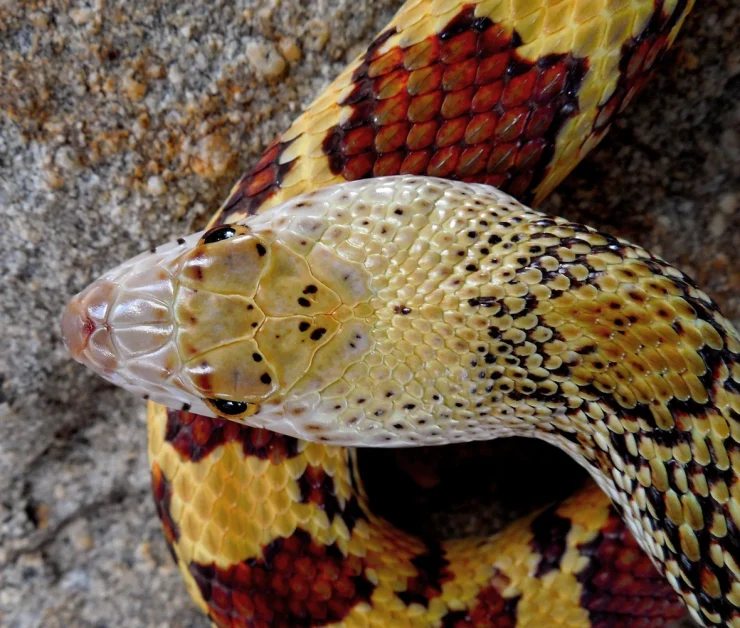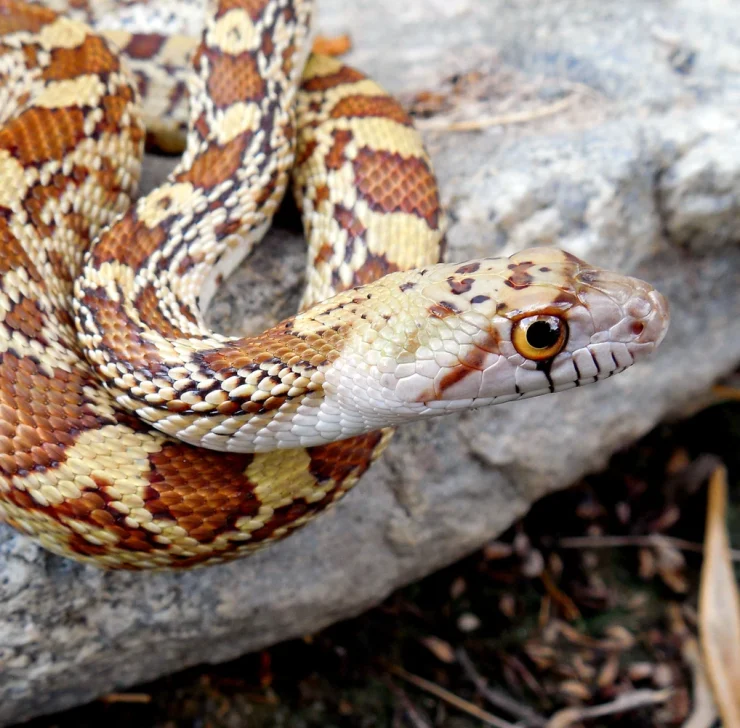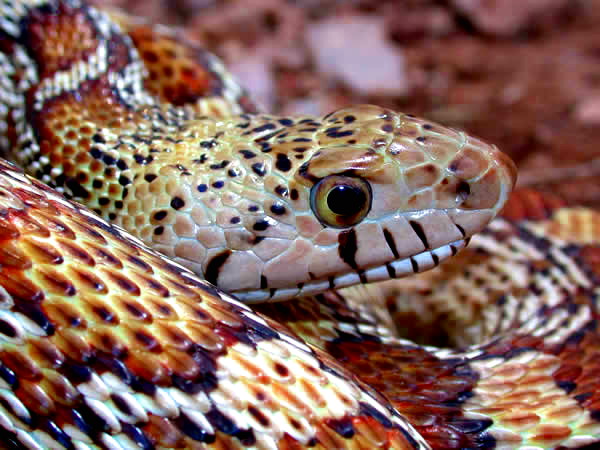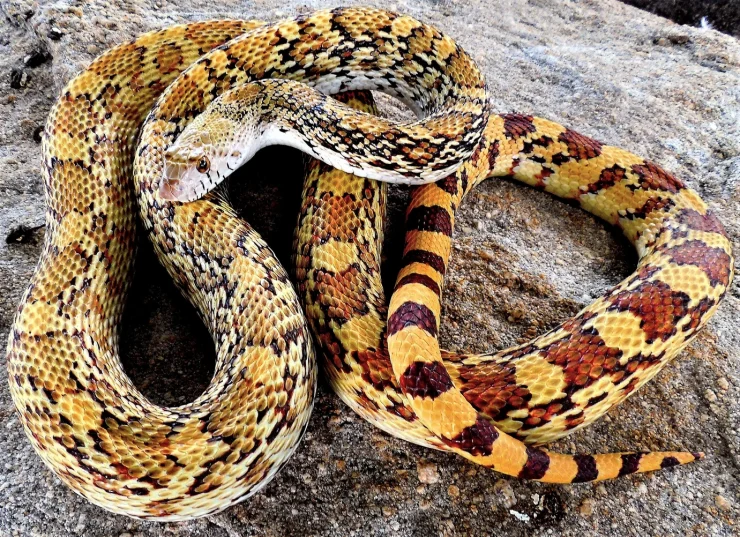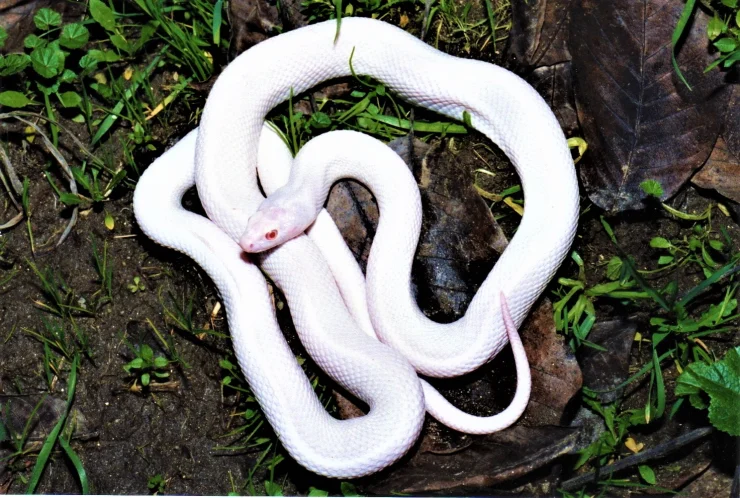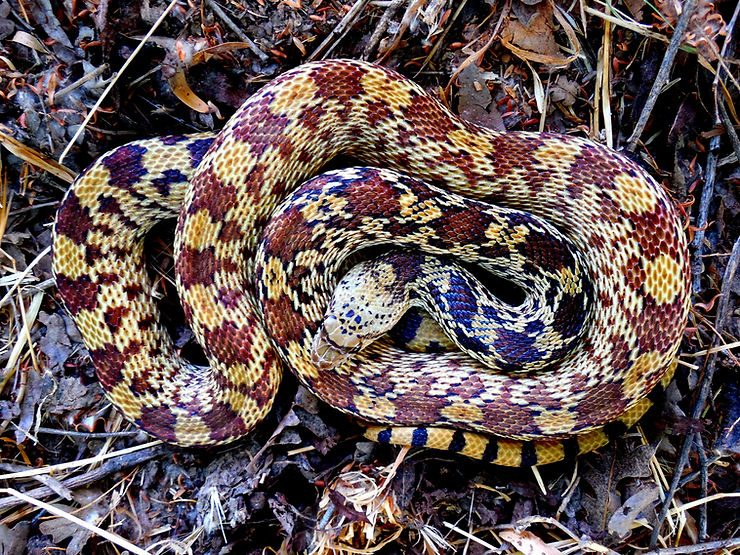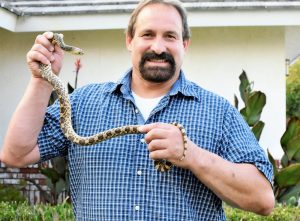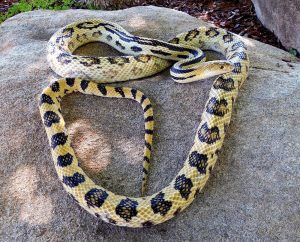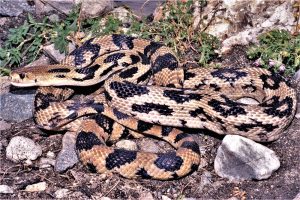SONORAN GOPHER SNAKE
Deming New Mexico, Luna County locality
By Patrick Houston Briggs, courtesy Rick Lewis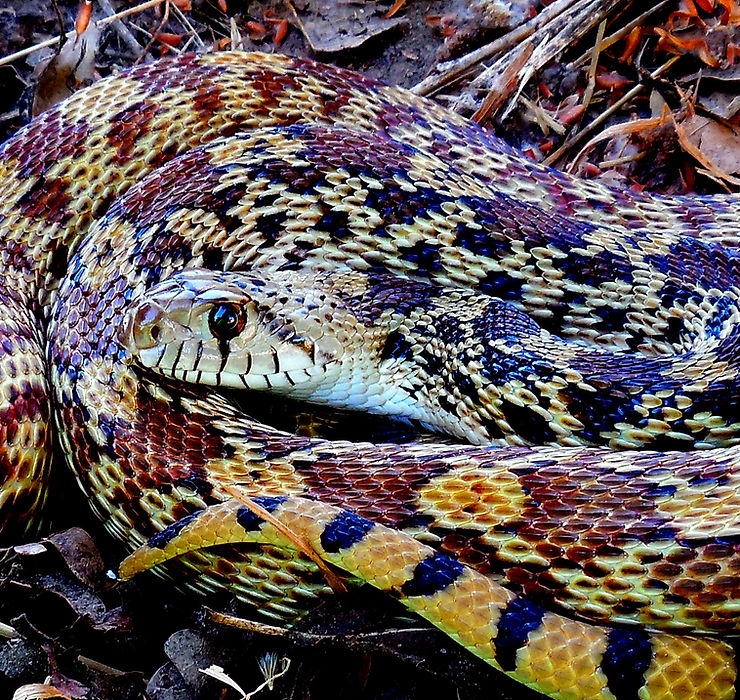
The SONORAN GOPHER SNAKE Pituophis catenifer affinis acquires its sub specific name from the Latin word affinis which means “related to” or “adjacent”. Hallowell in 1852 first called this form Pityophis affinis. From individuals collected in New Mexico, he first described this snake to have larger scales along the sides than those above on the back. The blotches on the dorsum are brownish sub quadrate and each is somewhat concave in front and behind. There are also 3 intercalary rows of smaller markings on each side. Very dark transverse bands are on a short tail with the abdomen and under the tail thickly maculated in dark brown. Like all other Pituophis species, it has sharp teeth, and although its strike or bite may cause only slight pain, it is harmless to humans. This race is indigenous to the southwestern United States and northwestern Mexico occurring in different shades of brown, reddish color, and beautiful morph patterns throughout its range. Just as commonly as many of the other races of the species catenifer, the affinis race many times intergrades with other races such deserticola or sayi and occasionally, natural hybrids of P. c. affinis x P. deppei are found at geographical borders where two forms come together. This produces populations at the bordering regions with pattern characters representing either both or one of the other forms.
Pituophis catenifer affinis SONORAN GOPHER SNAKE
Christmas Mountains Texas Parent Stock Locality
1.0 Digital image by Patrick Houston Briggs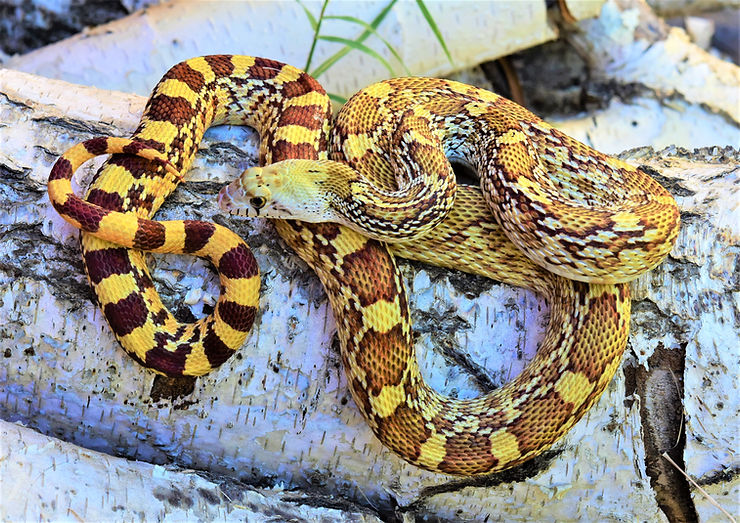
Pituophis catenifer affinis SONORAN GOPHER SNAKES 1.1 albino & normal morph
Image taken by Patrick H. Briggs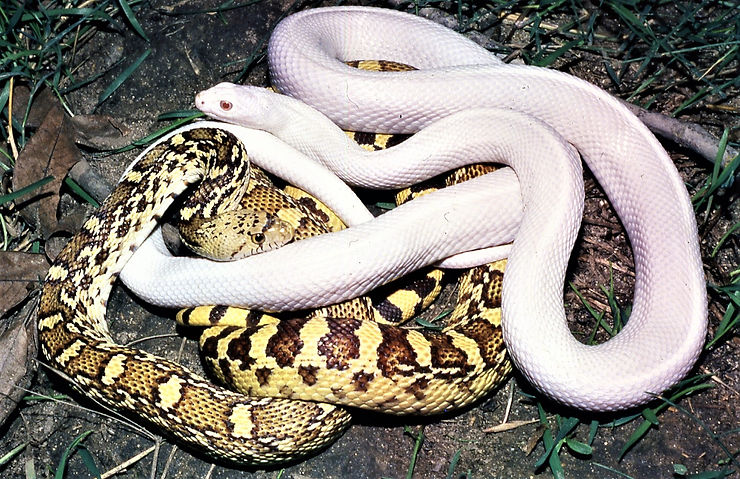
Pituophis catenifer affinis SONORAN GOPHER SNAKE
Image taken by Patrick Houston Briggs courtesy to the late Lloyd Lemke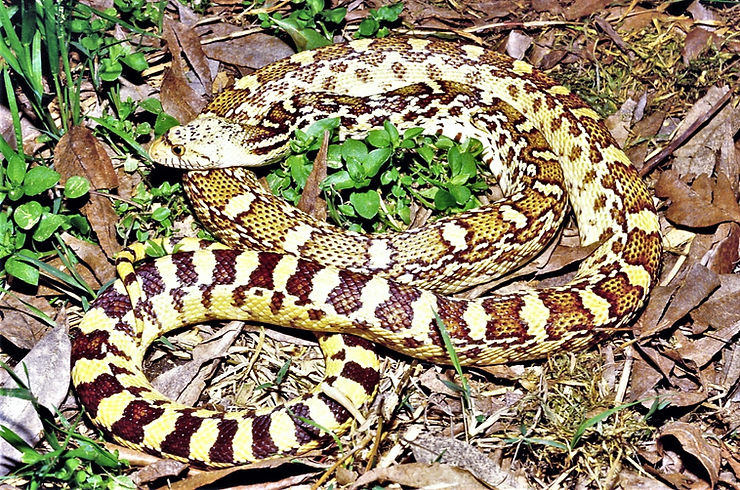
Lloyd Lemke (top snake breeder) and Patrick Houston Briggs enjoy a day at the Herpetological Society to speak on Keeping & Breeding Snakes
Photo by Paul Slocumb

Pituophis catenifer affinis SONORAN GOPHER SNAKE upper head closeup
Image by Patrick Briggs
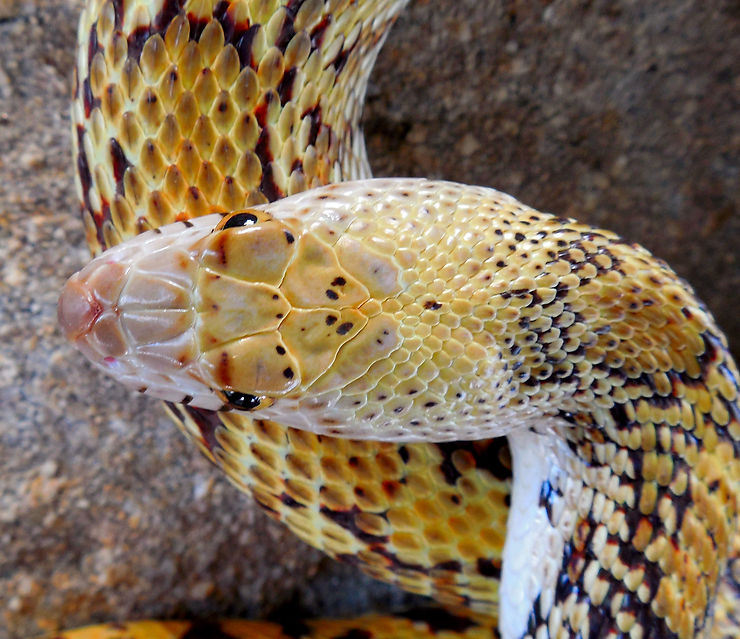
Patrick Briggs

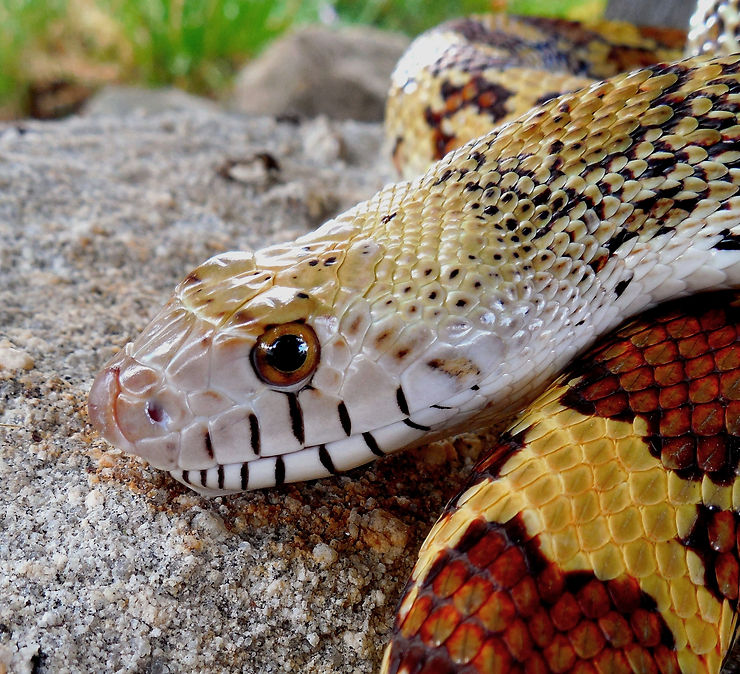
Hybrid SONORAN X GREAT BASIN GOPHER SNAKE
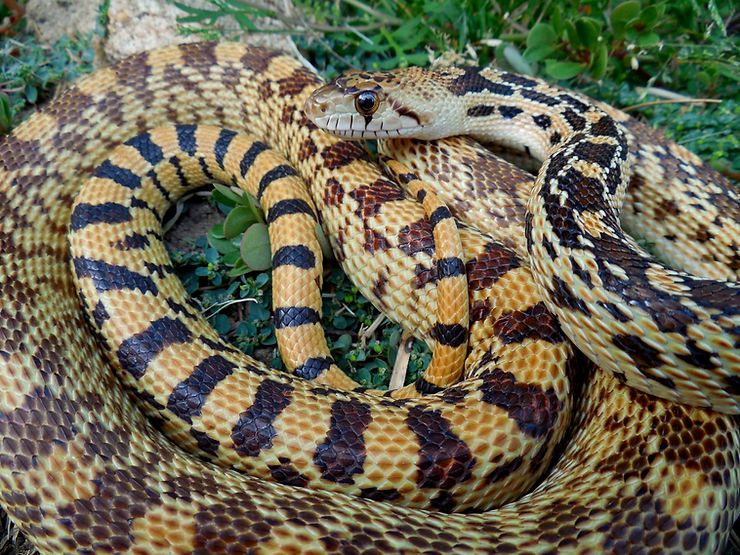
Blythe in Riverside County at the Colorado River border locality
Image by Patrick Brigg
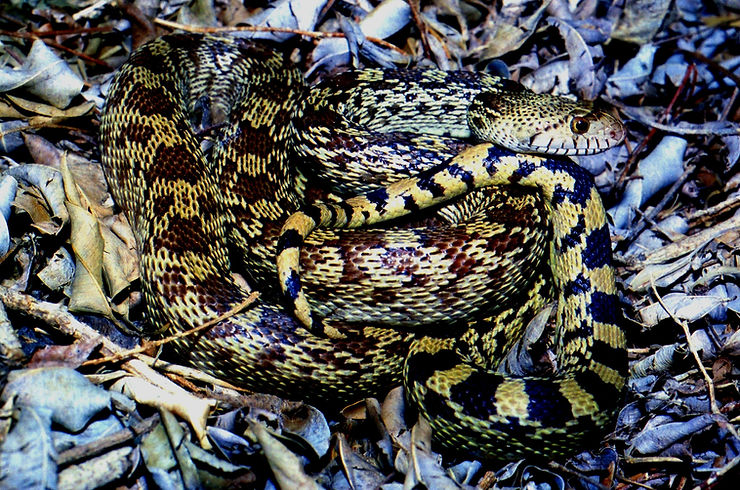
IDENTIFICATION: The Sonoran Gopher Snake is a large constrictor with a stout body that as an adult usually is about 3-5 feet in length. Even so, they can reach lengths up to 7 feet (213cm). The tail is reported to be 0.111 to 0.152 of the total body length. Its snout is neither blunt nor pointed, but moderately rounded. This race is heavily keeled throughout the length of the body. These keels or ridges that separate each scale are most defined on the upper rows of scales and weaken or completely fade out on the scale rows of each side nearest the belly. The rostral of this subspecies is rather broad, only slightly longer than broad, and only slightly raised above adjacent head scales if it is raised at all. The head is only slightly wider that the neck except when the snake is upset and is deliberately flexing the jaws as a threat display. Also, the head above is light colored and nearly always is dappled with small dots. The Sonoran gopher snake is anteriorly clad with 43-86 separate all brown or reddish dorsal blotches or spots on the body and tail. Anteriorly, the blotches are quadrangular may be grayish to reddish brown. Near the tail end, the blotches darken, may be nearly black, and are more or less saddle-shaped. These blotches are 3-7 scales in length and 9-11 scales in width and are delineated narrowly in black or very dark brown. These dorsal blotches may fuse one with another and with the lateral markings at their ends. Usually, the blotches are reddish and its ground color distinctly prettier than other gopher snakes, but occasionally, drabber looking individuals are collected. On each side, there are 3 lateral rows of smaller markings or spots with the same color as the vertebral blotches. These spots are also outlined narrowly with dark brown or black, and they alternate one with another. The lateral ground color is usually the same color as the dorsum with no ashy wash or suffusion of gray, but sometimes there is spotting. The Ventra is pale with a series of dark spots 1-2 scutes in length with a separation of 1-4 scutes. Consistent with most of the genus Pituophis and the other subspecies of catenifer, above the head, 4 prefrontal scales are usually present in Pituophis catenifer affinis.
HABITAT: The Sonoran Gopher Snake frequents varied habitat with cover and food. It can be found near streams and rivers, desert flats, scrub, grass land, and agricultural land. Its favorite areas to frequent are high grass or desert bushes, bare ground with many holes or tunnels, or rocky flat areas.
FOOD: Like all the others of the Pituophis clade, this race is a powerful constrictor. In the wild, it will begin to eat small lizards, young hairless rodents, and fledgling birds. As it grows to be an adult, the size of food animals that it can and will eat will respectively be larger and other types food items will be added such as eggs, rodents with hair or feathers, such as pocket gophers, rabbits, squirrels, chipmunks, and birds, and occasionally, small snakes. In captivity, hatchlings are fed young mice or rat (pinkies) subsequently increasing the size of mice or rats as the snake grows larger. Many keepers now choose to freeze freshly killed rodents and later thaw them out just before feeding. Usually frozen mice and rats are cheaper to purchase, and the labor, complications and smells associated with breeding rodents are eliminated.
BEHAVIOR: These snakes can usually be found lurking about their lairs during the daytime to thermal regulate their own bodies before searching out prey. In the summer, when the temperatures are the highest, they also become active at night and especially, from dusk to dawn. Tall grass or bushes are favorites to frequent, but rocky areas or bare ground with lots of holes are also good habitat. By extending and retracting their tongue, and rapidly inserting or touching the bifurcated tips into a paired organ in the palate of the mouth called the Jacobson’s organ, they taste and smell scent that leads them to food, water, and possible mates for sex. Much of their prey is found in underground animal burrows. They subdue these animals by pressing them up against tunnels or wall surfaces or by biting down to hold them in place as they coil around and suffocate the prey. In a different manner, young blind and hairless rodents and fledgling birds are usually swallowed without constriction or pressing them beforehand. As temperatures become colder, these snakes will go underground. They usually utilize animal tunnels and chambers, but they are also quite capable of making their own burrows or chambers and may modify a rodent chamber by moving soil or substrate with the upper coils of the body and pushing earth to one side or another using a re-enforced snout, the rostral, so that they may brumate during the winter. Although they tend to be more fossorial, Sonoran gopher snakes are good climbers and swimmers and will search out bird nests for food or even navigate water. If threatened, they may flatten the head and body, shake the tail like a rattler, hiss, strike, bite, or simply, slither to cover.
REPRODUCTION: In the wild, after overwintering, from March to May, as temperatures begin to elevate in the spring, these snakes begin looking for mates by tracking scent as they extend and retract the tongue and touch the olfactory organ in the palate of the mouth. After locating a mate, sometimes other males may be present and need to be ritually muscled away through intertwining, twisting, and pushing. The established male will slither along its female’s side, and attempt to impress her with some rubbing, flexing, nudging, and intertwining of body and tails. Subsequently, the male sometimes will grasp the female by the head or neck. Although it appears to be painful to her, she is well armed with scales so it is not, but rather, it serves to give the male leverage for the massaging and actual mating. When the tails are both lined up with the base of his tail pressing against the side of hers, he will wait for her readiness and willingness to mate when she raises her tail upward. He next, everts one of his two sexual organs known as hemepenes housed in the base of the tail and inserts it into one of the female’s two receptor pouches, also housed within the tail. The male has gripping spines that help hold the connection in place as sperm flows into one of her receptor pouches. This may take minutes or hours before separating, and they may hook up several times a day or several times within a few days. Within a couple months after mating, from June-August eggs will usually be laid underground where there is a more constant temperature and where the humidity remains high or she may choose to deposit her eggs under an object or in a substrate such as sand or ground litter that maintains temperatures from about 76 to about 85 degrees with good humidity (at least 75%). Many times, a female will also, hollow out an area underground using her snout and coils from the front part of her body. She lays leathery off white stretched like oval eggs that are able to absorb moisture from the ground. Depending on specific factors such as temperatures during incubation, the young snakes should hatch in about two to two and a half months. Young are 13-16 inches. After hatching, the hatchling snakes will appear somewhat darkened, but a few days to a week or so later, they will slough off an outer skin layer and will appear as a beautifully colored neonate snakes. Adults are usually 50-72 inches long with a record reportedly 92 inches (233.7 cm). Even so, captive snakes often, are proving to grow much larger than the wild record.
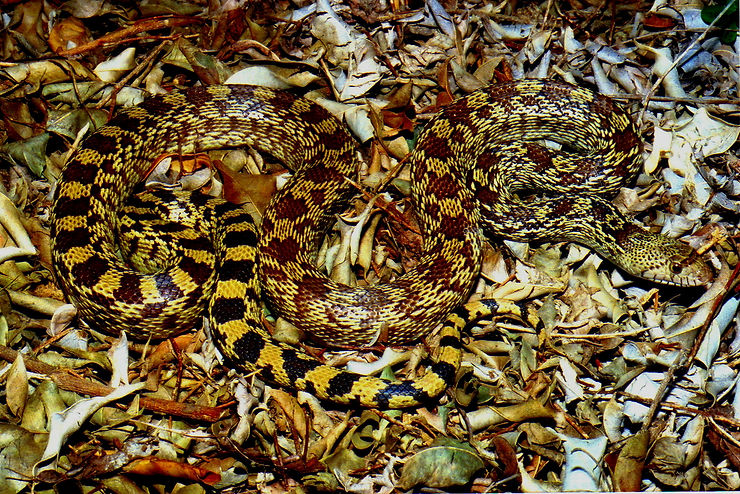
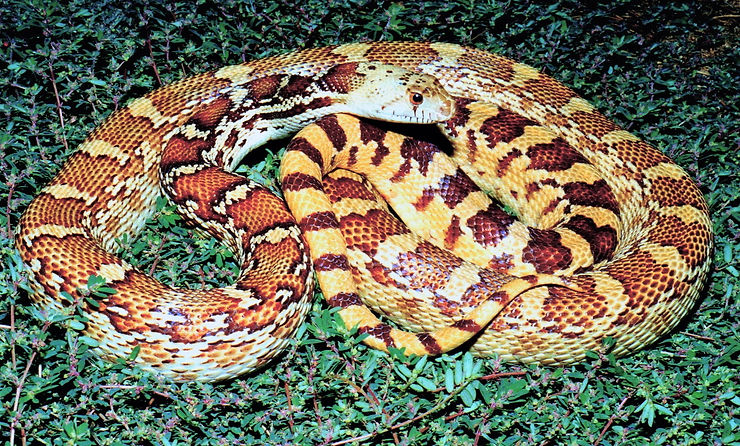
Albino White Head
Image by Pat Briggs, Courtesy to Lloyd Lemke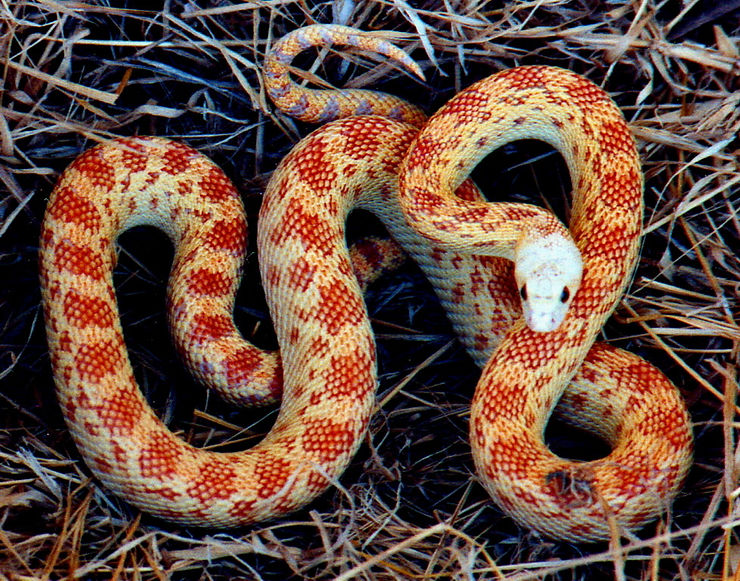
Pituophis catenifer affinis SONORAN GOPHER SNAKE
albino
Image by Pat Briggs
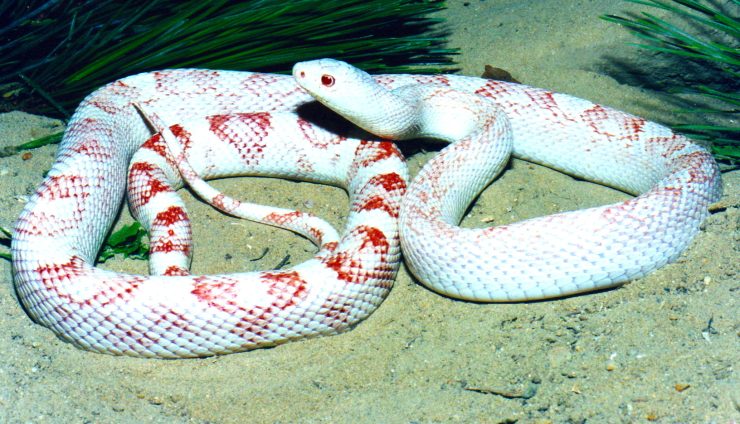
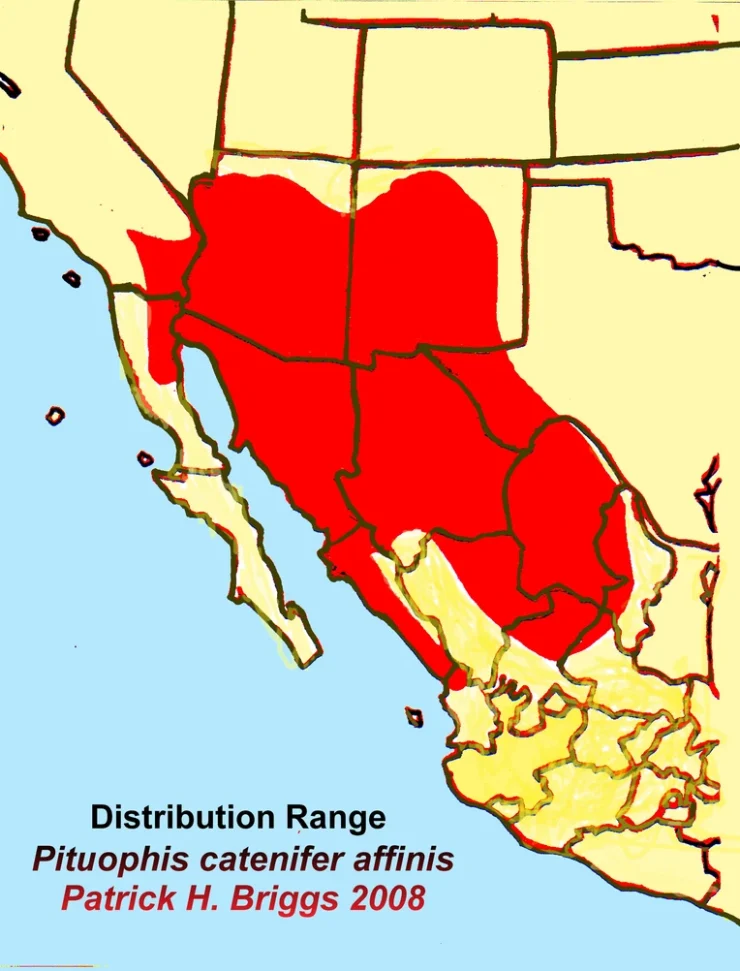
CONSERVATION STATUS: As of January 2014, there were no known conservation listings for this subspecies of Pituophis under any major organizations such as U.S. Endangered Species Act (ESA) or World Conservation Union (IUCN) Red List.
SCUTELLATION:
Caudals 51-71
Anal entire
Pre-frontals 4-7
the center for as much as 1/2 of its length)
and pre-frontals, or a small one on each side
The DENTITION of the mandibular teeth are 18-19 gradually becoming smaller in size towards the back. The maxillary teeth are 16-17 also decreasing slightly in size posteriorly. The palatines are 8-10 and are smaller than both the mandibular and the maxillaries. the pterygoids number 10-14 slightly smaller than the palatines and also decrease in size posteriorly.
Pituophis catenifer affinis SONORAN GOPHER SNAKE
albino
Image by Pat Briggs
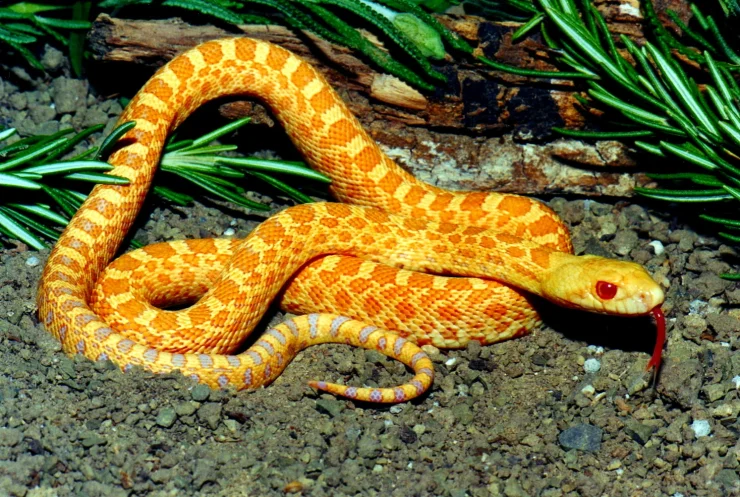
Pituophis catenifer affinis SONORAN GOPHER SNAKE
Albino
Image by Pat Briggs, Courtesy Lloyd and Sonnie Lemke
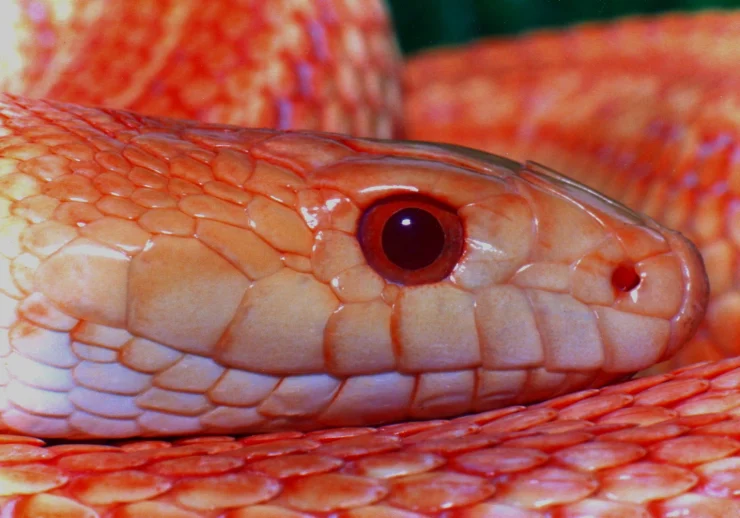
Image by Pat Briggs
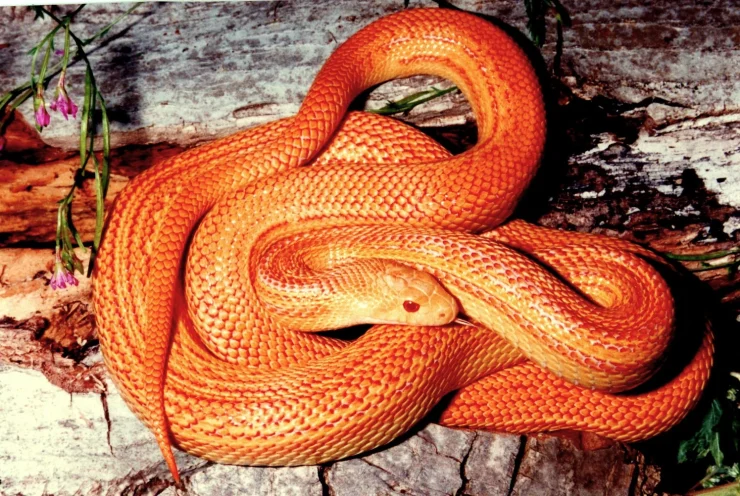
Albino Blotched Reddish
Image by Pat Briggs
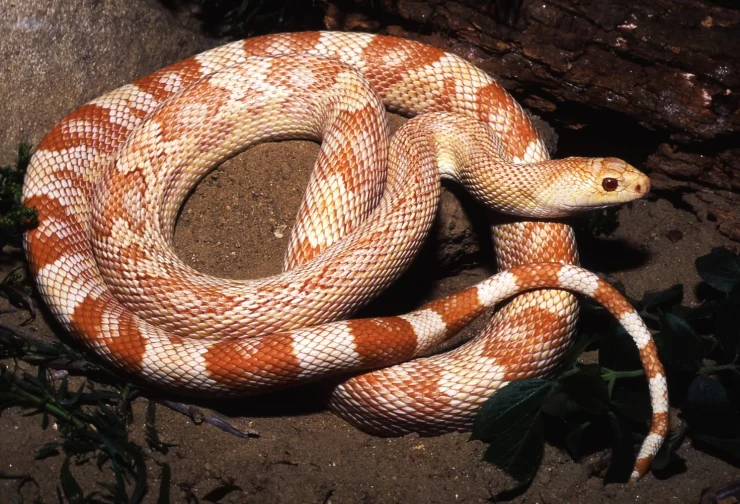
Christmas Mountains Texas parent stock locality
Image by Patrick Houston Briggs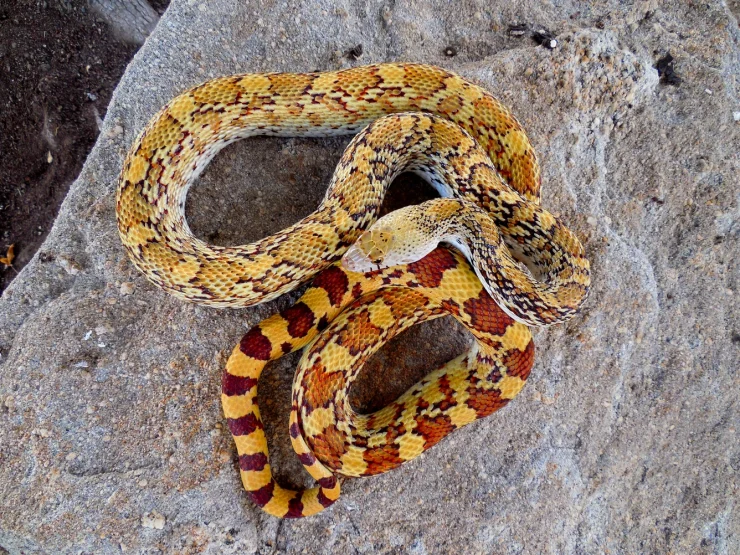
Christmas Mountains Texas parent stock locality closeup upper head study
Image by Patrick Briggs
